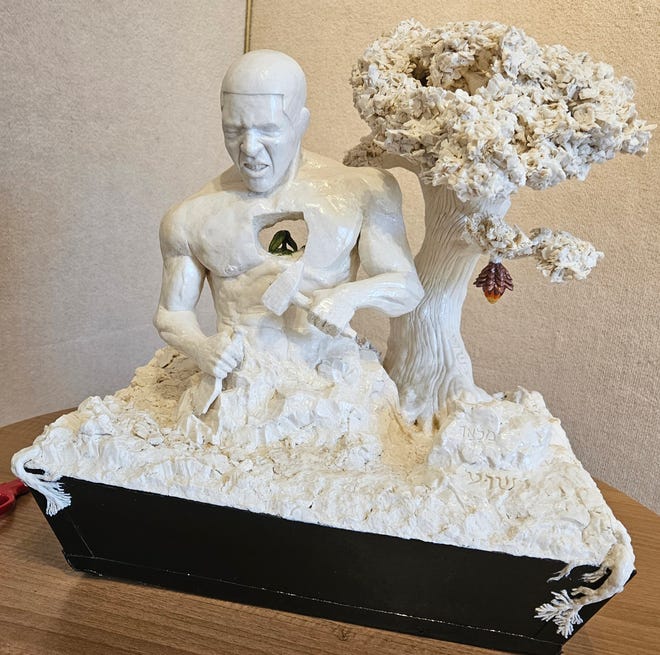
They’ve just arrived at the Museum. The works of art. The makings of a spectacular exhibition of hand-crafted pieces. Each, one might say, a reflection of an artist’s soul. As with all new shows, the electricity of anticipation is in the air as museum staff bustles the pieces inside Tallahassee’s LeMoyne Arts.

From a white van, sculptures, carvings, paintings, and assemblages are carefully lifted and carried by the curators and consultants up the stairs and into the galleries where they will be on display for their exclusive viewing — Oct. 22-Nov. 2.
And why “exclusive?” And why not a longer run? The answer is to be found on the license plate of the white van. “Madison” it says. More specifically, “Madison Correctional Institution.
The exhibit of art created by prisoners at Madison Correctional Institution on display at LeMoyne, “Connections Without and Within,” opens from 5-7:30 p.m. Tuesday, Oct. 22.
This art does not actually “belong” to the artists who created it, but to the state of Florida. These pieces, filled with remarkable artistic virtuosity and certainly stunning imagination cannot be bought or sold — in fact only with special permission are the works leaving the prison at all.
Need a break? Play the USA TODAY Daily Crossword Puzzle.
Arts program in prison
And yet, ask any artist, the ones found in an exclusive studio or in a prison, and purpose is not to be found in top-dollar sales or even high-end galleries, but rather in the act of the creation — in the speaking to a viewer in a language that doesn’t need words nor cash.

Approximately 10 years ago, Madison Correctional prison employee, Sgt. Rolaunda Mitchell founded the program now known as M.A.P., the Madison Arts Program. It is described as, “a coordinated effort by the staff and administration to positively support individuals during their incarceration so that they experience long-term positive outcomes.”
Using “arts-based” and “values-based” programming, the goal is to help inmates achieve “their full-potential and to lead purposeful lives.”
The M.A.P. program also includes Literary Arts Classes involving basics like grammar and sentence building, as well as Writer’s Workshops and Poetry. Performing Arts Classes offer: chorus, drama and improv, music appreciation, and song writing. Sgt. Mitchell writes that the program hopes to allow the men who leave the program to be “visibly transformed—creative, not destructive, who can create goal-oriented plans for a successful and lasting reintegration.”
And Sgt. Mitchell, a bright, beaming woman in a severe black-colored uniform, continues to innovate for her program.
Experts, paper and soap
She has found outside colleagues and expertise to assist. Dr. David Gussak, Professor of Art Therapy for the last 20 years at FSU and currently Program Director of the FSU/FI Department of Corrections’ Art Therapy in Prisons and Paula Gasparini-Santos, an artist, art therapist, and grief counselor, have recently spent three days a week over two weeks intensively working with the incarcerated artists.
“The art output of these men is astonishingly good,” says Santos. “But what we asked them was: “Who are you as artists?” “And how to create that bridge between what you feel and what you do — between what is inside and what is outside. We asked them ‘to go deep.’ “
Gussak says that the prison has created a “special place” for the nearly 20 men who are making art. “They actually live in a separate dorm where the emphasis is on creation. They work in what is basically a community space, where others may be playing pool or games, but where these men create art.”

But being an artist in a prison has certain parameters. For instance, what media you can create with. Cardboard, paper, and soap, it turns out can hold magic if you’ve got talent and will.
On display at the LeMoyne are two over-12-foot giant totem poles with detachable wings and beaks, brilliantly painted on break-away cardboard cylinders. There are several monolithic chess pieces, also cardboard, that were created by the men for compatriots in the “yard” to play a game of chess during a festival.
Brilliant paintings in acrylic and watercolor are careful and delicate; some large works of vernacular art seem to dance with artistic free-association. And then there are two seemingly impossible crafted works in soap.
No names, powerful symbolism

None of the art bears a name or signature — only initials or symbols are used. This is the case with two works carved from soft prison soap. The first, an approximately 18” x 18” sculpture shows an intricately constructed oak tree with tiny leaves and thinly-grained bark which leans beside the form of a man.
The masculine figure is powerful, perhaps angry, holding a chisel and a hammer, and himself seems to erupt from the earth. Yet inside the chest of the man is a carved-away opening, and in the opening is a delicate, but very healthy, green leaf. The symbolism is powerful.
Another soap sculpture varnished in brown suggests an indigenous portrait.
Gussak who has written numerous acclaimed books about his work with incarcerated persons says that “these guys are just so grateful and moved by being able to exhibit their work in a museum like the LeMoyne. Now, others will see not just their work, but see them. It validates them. It acknowledges them as people.”
And isn’t that just what we all want in the end.
If you go
What: “Connections Without and Within,” art from the inmates of the Madison Correctional Institution
When: 5-7:30 p.m. Tuesday, Oct 22, opening
Where: LeMoyne Museum, 125 N. Gadsden St.
Panel discussion: 11-12:0 p.m. Saturday, Oct 26, with staff of Madison Correctional Institution. Muffins and Mimosas.
This post was originally published on this site be sure to check out more of their content.






